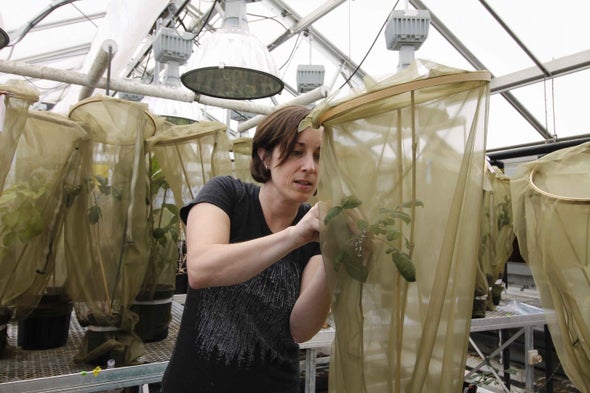(单词翻译:单击)
听力文本
This is Scientific American — 60-Second Science, I'm Shahla Farzan.
Insects can be noisy. But most of the sounds they produce, we can't hear. Take tiny insects called treehoppers. They communicate by producing vibrations. When a male treehopper is hunting for a mate, he vibrates his body to produce a special love song.
"They sound like oooo-boo-boo-boop."
Kasey Fowler-Finn is an assistant professor of biology at Saint Louis University. She says if a female treehopper is interested, she'll vibrate back to the male. Basically, her way of saying, "Hey, there."
Fowler-Finn wondered if treehopper mating songs might change at different temperatures, which could affect whether the species survives as the climate changes. So she and graduate student Dowen Jocson built custom incubators, using plywood and Ikea shelves—plus, a laser that helps them listen to treehoppers.
"The laser receives information about these tiny vibrations on the plant stem, which we then amplify and process into sounds that we can hear."

Turns out, the treehoppers do sound different when the temperature changes. Here's a male singing at 65 degrees.
(CLIP: Insect sound)
And another at 97 degrees.
(CLIP: Second insect sound)
But that's not all. The team recorded these songs and played them for females to see if they still found them attractive.
"So essentially, we're having a conversation with the insect, because we can play back a bunch of different signals to females and ask her how much she likes each one."
As male treehopper love songs changed across temperatures, females still recognized them—saying, "Yep, I'm interested in mating with you." Jocson says that was exciting.
"I think when we saw that, we were just like, 'Wow, this is awesome.'"
The study is in the Journal of Evolutionary Biology.
She says this just one piece of the puzzle. But it gives her some hope that treehoppers and other similar insect species will keep things steamy—even as the climate warms.
For Scientific American — 60-Second Science. I'm Shahla Farzan.
参考译文
这里是科学美国人——60秒科学系列,我是夏拉·法尔赞。
昆虫很吵。但它们发出的大多数声音人类都无法听见。以名为角蝉的小昆虫为例。它们通过振动进行交流。当雄性角蝉寻找配偶时,它会振动身体奏出一首特别的情歌。
“声音听起来像呜呜-呜呜-呜呜。”
圣路易大学的生物学助理教授凯西·福勒-芬恩说到。她表示,如果雌性角蝉感兴趣,就会用振动回应雄性。基本上,她是在说,“嘿,你好”。
福勒-芬恩想知道,角蝉的求偶歌声在不同温度下是否会发生变化,这可能会影响这个物种是否能在气候变化中存活下来。因此,她和研究生道恩·乔森用胶合板、宜家的置物架以及一种帮助他们倾听角蝉声音的激光建造了定制孵化器。
“激光接收植物茎上的微小振动,然后我们将其放大并处理成我们可以听到的声音。”
结果表明,角蝉的声音的确会随着温度的变化而变化。这是一只雄性角蝉在65度的环境中唱歌的声音。
(音频剪辑:昆虫的声音)
这是另一只角蝉在97度环境下的声音。
(音频剪辑:第二只昆虫的声音)
还没有结束。研究小组将这些歌曲录制下来,然后播放给雌性角蝉听,看看她们是否仍然觉得这些歌曲有吸引力。
“本质上来说,我们是在和昆虫对话,因为我们可以向雌性回放大量不同信号,观察她对每种信号的喜爱程度。”
当雄性角蝉的情歌随着温度的变化而变化时,雌性仍然能认出他们,并回应说,“是的,我有兴趣和你交配。”乔森说,这令人相当兴奋。
“我想,当我们看到这个场景时,我们的反应是:‘哇哦,这太棒了。’”
这项研究发表在《进化生物学》期刊上。
她表示,这只是冰山一角。但她从中获得了希望:即使气候变暖,角蝉和其他类似的昆虫物种也能继续繁衍生息。
谢谢大家收听科学美国人——60秒科学。我是夏拉·法尔赞。
译文为可可英语翻译,未经授权请勿转载!
重点讲解
重点讲解:
1. hunt for 搜寻;寻找;
A forensic team was hunting for clues.
法医小组正在寻找线索。
2. turn out 原来是;结果发现;
Cosgrave's forecast turned out to be quite wrong.
科斯格雷夫的预测最后证明是大错特错。
3. a bunch of 大量;大批;
We did a bunch of songs together.
我们一起唱了很多首歌。
4. be interested in 感兴趣的;有兴趣的;关心的;
As a writer I am interested in characterization.
作为作家,我对人物塑造感兴趣。


